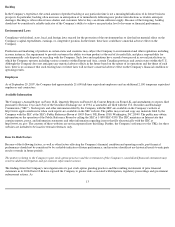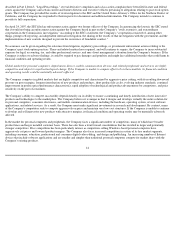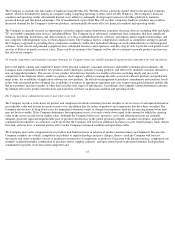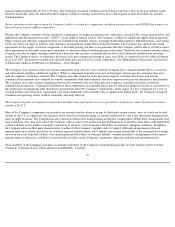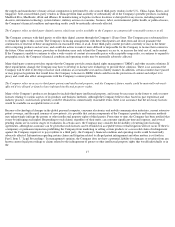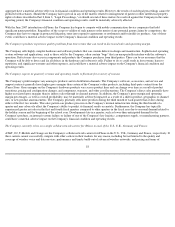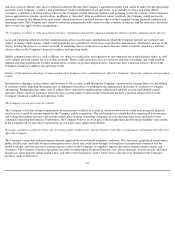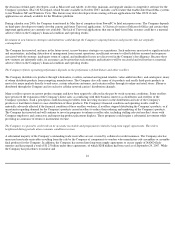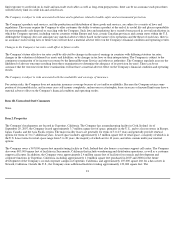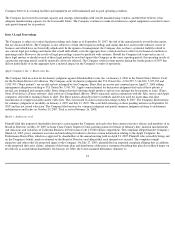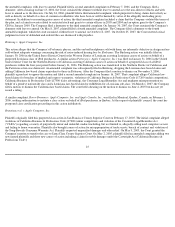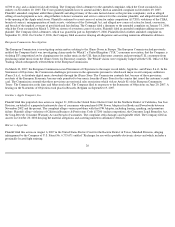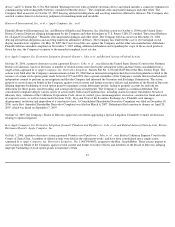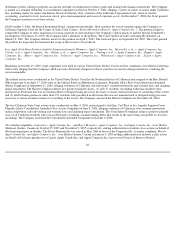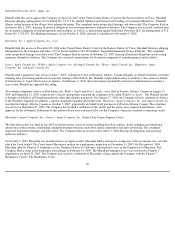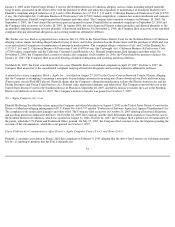Apple 2007 Annual Report Download - page 25
Download and view the complete annual report
Please find page 25 of the 2007 Apple annual report below. You can navigate through the pages in the report by either clicking on the pages listed below, or by using the keyword search tool below to find specific information within the annual report.
the decisions of third-party developers, such as Microsoft and Adobe, to develop, maintain, and upgrade similar or competitive software for the
Company's products. Mac OS X Leopard, which became available in October 2007, includes a new feature that enables Intel-
based Mac systems
to run Windows XP and Windows Vista. This feature may deter developers from creating software applications for Mac OS X if such
applications are already available for the Windows platform.
During calendar year 2006, the Company transitioned its Mac line of computers from PowerPC to Intel microprocessors. The Company depends
on third-party developers to timely develop current and future Universal applications. A Universal version of Microsoft Office and certain other
important applications are currently not available. The lack of Universal applications that run on Intel-based Mac systems could have a material
adverse effect on the Company's financial condition and operating results.
Investment in new business strategies and initiatives could disrupt the Company's ongoing business and present risks not originally
contemplated.
The Company has invested, and may in the future invest, in new business strategies or acquisitions. Such endeavors may involve significant risks
and uncertainties, including distraction of management from current operations, insufficient revenue to offset liabilities assumed and expenses
associated with the strategy, inadequate return of capital, and unidentified issues not discovered in the Company's due diligence. Because these
new ventures are inherently risky, no assurance can be given that such strategies and initiatives will be successful and will not have a material
adverse effect on the Company's financial condition and operating results.
The Company's future operating performance depends on the performance of distributors and other resellers.
The Company distributes its products through wholesalers, resellers, national and regional retailers, value-
added resellers, and cataloguers, many
of whom distribute products from competing manufacturers. The Company also sells many of its products and resells third-party products in
most of its major markets directly to end-users, certain education customers, and certain resellers through its online and retail stores. iPhone is
distributed through the Company and its exclusive cellular network carriers' distribution channels.
Many resellers operate on narrow product margins and have been negatively affected in the past by weak economic conditions. Some resellers
have perceived the expansion of the Company's direct sales as conflicting with their business interests as distributors and resellers of the
Company's products. Such a perception could discourage resellers from investing resources in the distribution and sale of the Company's
products or lead them to limit or cease distribution of those products. The Company's financial condition and operating results could be
materially adversely affected if the financial condition of these resellers weakens, if resellers stopped distributing the Company's products, or if
uncertainty regarding demand for the Company's products caused resellers to reduce their ordering and marketing of the Company's products.
The Company has invested and will continue to invest in programs to enhance reseller sales, including staffing selected resellers' stores with
Company employees and contractors and improving product placement displays. These programs could require a substantial investment while
providing no assurance of return or incremental revenue.
The Company is exposed to credit risk on its accounts receivable and prepayments related to long-term supply agreements. This risk is
heightened during periods when economic conditions worsen.
A substantial majority of the Company's outstanding trade receivables are not covered by collateral or credit insurance. The Company also has
unsecured non-trade receivables resulting from the sale by the Company of components to vendors who manufacture sub-
assemblies or assemble
final products for the Company. In addition, the Company has entered into long-term supply agreements to secure supply of NAND flash-
memory and has prepaid a total of $1.25 billion under these agreements, of which $208 million had been used as of September 29, 2007. While
the Company has procedures to monitor and
22



